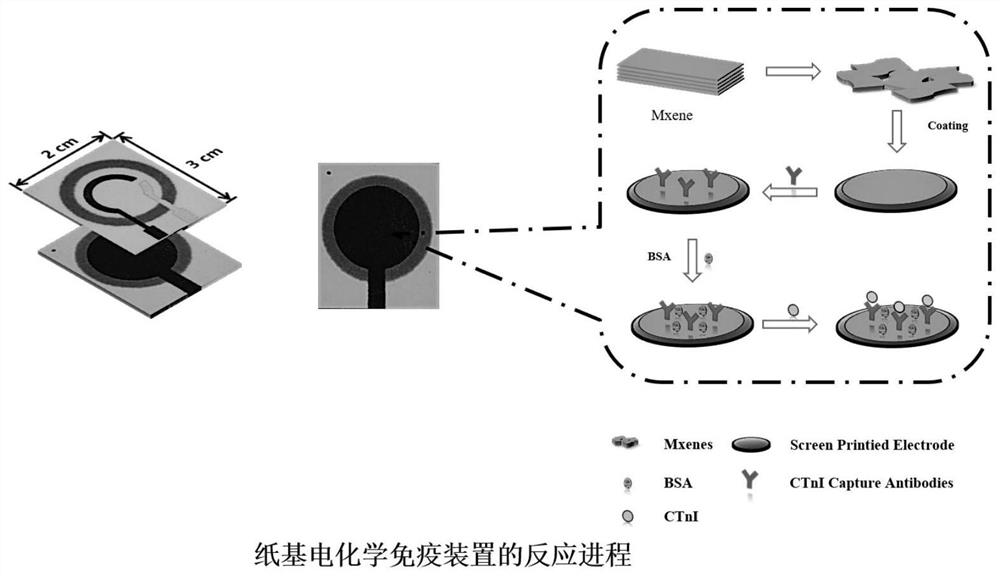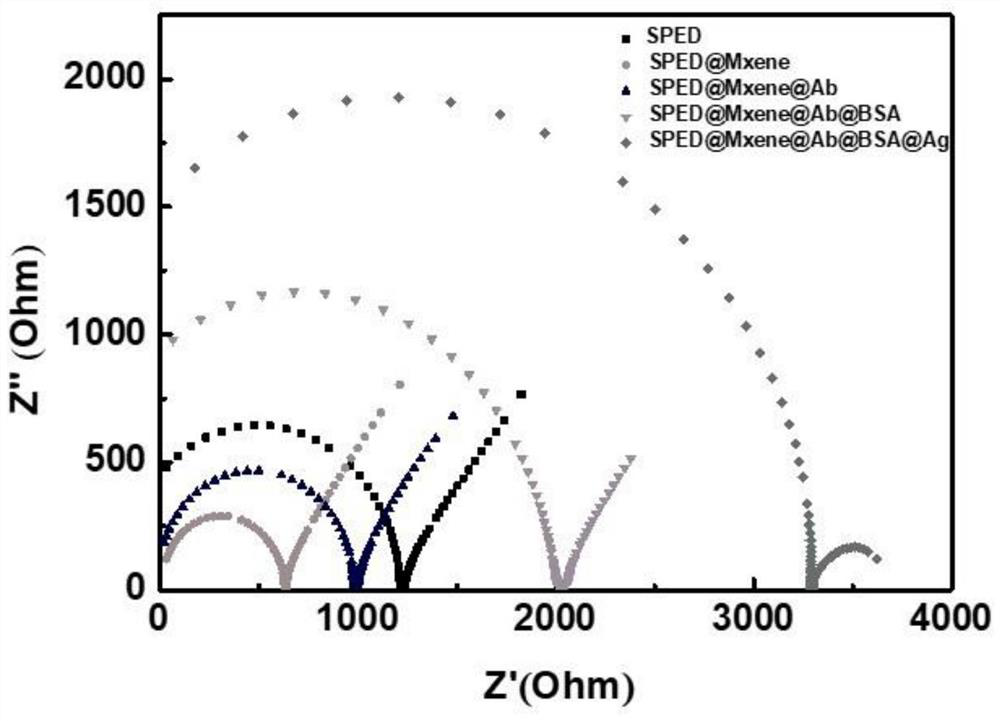Microfluidic paper-based sensor for detecting cardiac troponin I based on single-layer MXene enhanced signal for electrochemical analysis
A technique for cardiac troponin and electrochemical analysis, applied in the field of biological nanometers, can solve the problems of difficult promotion, high cost, complicated sample processing, etc., and achieve the effects of wide application range, low cost and high sensitivity
- Summary
- Abstract
- Description
- Claims
- Application Information
AI Technical Summary
Problems solved by technology
Method used
Image
Examples
Embodiment 1
[0038] A microfluidic paper-based sensor for detecting cardiac troponin I with MXene-enhanced signal based on electrochemical analysis, including the following steps:
[0039] a. Formation of plasma treated paper
[0040] 1) Design a paper-based model of a certain size, and form a hydrophilic area and a hydrophobic area through wax spray printing technology;
[0041] 2) Bake at 90°C for 5 minutes;
[0042] 3) Treat the paper with a plasma cleaner for 4 minutes to obtain the required paper;
[0043] 4) The plasma-treated paper needs to be sealed before adding samples to prevent oxidation.
[0044] b. Preparation of monolayer MXene
[0045] 1) Stir and mix 5mL water, 15mL hydrochloric acid and 1g lithium fluoride evenly;
[0046] 2) Add 1g of MXene precursor (MAX) and stir at 35°C for 24h;
[0047] 3) Centrifuge at 3500rpm for 5min, pour off the supernatant, repeat 8 times until the supernatant becomes dark green;
[0048] 4) Sonicate for 1h, centrifuge at 3500rpm for 1h, ...
Embodiment 2
[0066] A microfluidic paper-based sensor for detecting cardiac troponin I with MXene-enhanced signal based on electrochemical analysis, including the following steps:
[0067] a. Formation of plasma treated paper
[0068] 1) Design a paper-based model of a certain size, and form a hydrophilic area and a hydrophobic area through wax spray printing technology;
[0069] 2) Baking at 100°C for 5 minutes;
[0070] 3) Treat the paper with a plasma cleaner for 4 minutes to obtain the required paper;
[0071] 4) The plasma-treated paper needs to be sealed before adding samples to prevent oxidation.
[0072] b. Preparation of monolayer MXene
[0073] 1) Stir and mix 5mL water, 15mL hydrochloric acid and 1g lithium fluoride evenly;
[0074] 2) Add 1g of MXene precursor (MAX) and stir at 35°C for 24h;
[0075] 3) Centrifuge at 3500rpm for 5min, pour off the supernatant, repeat 8 times, wait until the supernatant
[0076] become dark green;
[0077] 4) Shake for 1h, centrifuge at 3...
Embodiment 3
[0095] The present invention will be further described below in conjunction with accompanying drawing.
[0096] figure 1 It is the detection principle of the microfluidic paper-based sensor for detecting cardiac troponin I based on the MXene enhanced signal for electrochemical analysis of the present invention.
[0097] figure 2 is the atomic force microscope (AFM) image of MXene
[0098] image 3 It is the impedance spectrogram characterization of antigen-antibody binding to the working electrode.
[0099] Figure 4 are the chronoamperometric spectra of different concentrations of cTnI.
[0100] Figure 5 is the specific detection map of the paper-based detection device
[0101] A microfluidic paper-based sensor for detecting cardiac troponin I with MXene-enhanced signal based on electrochemical analysis, including the following steps:
[0102] a. Formation of plasma treated paper
[0103] 1) Design a paper-based model of a certain size, and form a hydrophilic area ...
PUM
 Login to View More
Login to View More Abstract
Description
Claims
Application Information
 Login to View More
Login to View More - R&D
- Intellectual Property
- Life Sciences
- Materials
- Tech Scout
- Unparalleled Data Quality
- Higher Quality Content
- 60% Fewer Hallucinations
Browse by: Latest US Patents, China's latest patents, Technical Efficacy Thesaurus, Application Domain, Technology Topic, Popular Technical Reports.
© 2025 PatSnap. All rights reserved.Legal|Privacy policy|Modern Slavery Act Transparency Statement|Sitemap|About US| Contact US: help@patsnap.com



